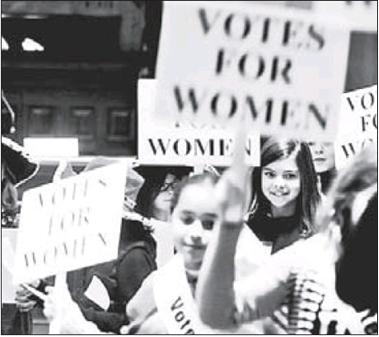The Right to Vote

THE right of the citizens to vote for their own leaders is one of the fundamental principles of liberty upon which the US was founded 235 years ago. Yet, American women have only been allowed to vote for the past 90 years, with the passage of the 19th Amendment to the Constitution in 1920.
The official term for the right to vote is suffrage, and without suffrage, women were suffering. They were denied education and employment, had few civil rights and no property rights and were powerless to change the laws that governed them because they could not vote.
In the summer of 1848, two anti-slavery activists, Elizabeth Cady Stanton and Lucretia Mott, organized the first womens rights convention in Seneca Falls, NY. The convention produced the Declaration of Sentiments, which demanded sweeping political and social reforms, including the right to vote for women.
In 1851, Stanton met fellow anti-slavery activist Susan B. Anthony during an antislavery convention in Seneca Falls. They teamed up to lead the womens suffrage movement, working tirelessly, during their historic, 50-year partnership, on behalf of womens economic and civil rights. However, neither Stanton nor Anthony lived to see the passage of the 19th Amendment.
In 1867, the State of New York turned down an appeal by Stanton, Anthony and fellow suffragist Lucy Stone, to include womens suffrage in the state constitution. The trio also campaigned across Kansas in support of a state referendum that would have granted suffrage to women and blacks. The referendum was voted down.
In 1870, black men were granted the right to vote by the passage of the 15th Amendment, but Stanton and Anthony vehemently opposed the amendment because it marked the first time language in the Constitution would specifically limit voting rights to men.
In 1871, the suffragist Victoria Woodhull argued before the House of Representatives that women have the constitutional right to vote under the 14th Amendment, which grants equal protection to all persons under the law. In November of 1872, Anthony and a group of women tested the theory by voting, but they were arrested and jailed. In 1874, the Supreme Court ruled that citizenship does not give women the right to vote, and that suffrage is a matter for the states.
By the turn of the century, however, many states were enfranchising women, with western states and territories leading the way. Nearly 50 years on, the movement was now being led by a new generation of suffragists, including Alice Paul, who had led 8,000 women on suffrage march through Washington, DC, and Carrie Chapman Catt, the founder of the League of Women Voters.
In 1917, Alice Paul and fellow suffragists Lucy Burns were among a group of women arrested for demonstrating outside the White House. When Paul and Burns went on a hunger strike during their incarceration, they were force-fed by the authorities.
Finally, in 1918, President Woodrow Wilson came out in support of a constitutional amendment guaranteeing womens suffrage. It would take two years for Congress to pass the amendment and for the states to ratify it, but on Aug. 26, 1920, the 19th amendment was ratified.
American women had won their fight for the right to vote.
Picture above: Students from area schools in Indiana re-enact an 1894 court case involving the legal battle for womens right to vote.

